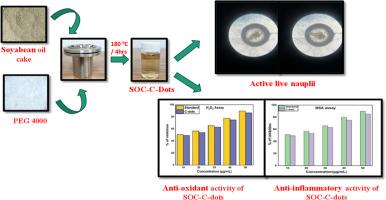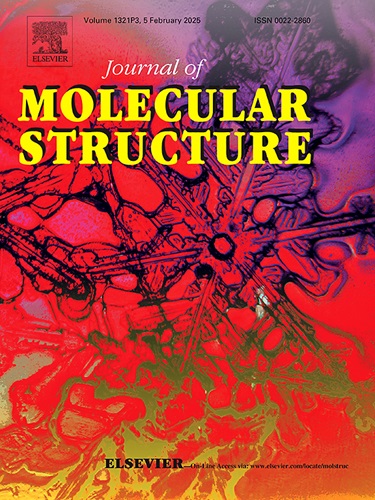探索用于体外生物医学应用的高附加值豆油饼基碳量子点
IF 4
2区 化学
Q2 CHEMISTRY, PHYSICAL
引用次数: 0
摘要
碳量子点(C-dots)具有毒性小、水溶性好和生物相容性强等显著特点,因此激发了生物医学研究人员的好奇心。本研究采用一种环境友好型水热法,从大豆油饼(SOC)中制备高荧光农业残留物衍生碳量子点。研究人员利用高分辨率透射电子显微镜(HR-TEM)、紫外可见光谱(UV-Vis)、光致发光(PL)、傅立叶变换红外光谱(FT-IR)、X 射线衍射分析(XRD)、Zeta 电位和拉曼光谱等理化技术对合成的 SOCC-Dots 进行了检测。由于存在π→π*转变的 C = O 键,在 275 纳米处出现了明显的吸收峰。合成的 SOCC-Dots 显示出存在多个官能团 OH、C = O 和 CO 伸缩振动。通过 HR-TEM 分析光谱,收集到的颗粒呈球形,平均粒径为 3.25 nm。光致发光在各种激发波长下都表现出稳定性,在 445 纳米处有一个最大发射峰。使用牛血清检测法对抗炎活性进行了测试,结果表明,由于 SOCC 点具有出色的生物相容性和水溶性,因此在浓度为 50 µg/mL 时,其抗炎活性达到了 87.4%。细胞毒性评估结果表明,浓度为 80 微克/毫升时,48 小时后稚虫的存活率为 85%;抗氧化活性表现出色,浓度为 50 微克/毫升时,SOCC-点的有效率为 87%。本文章由计算机程序翻译,如有差异,请以英文原文为准。

Exploration of value-added soybean oil cake based carbon quantum dots for in-vitro biomedical applications
Carbon quantum dots (C-dots) enthused the inquisitiveness of investigators in biomedicine due to their distinctive features including minimal toxicity, superior water solubility and biocompatibility. This study uses an environmental friendly hydrothermal approach to create high-fluorescent agricultural residue-derived carbon quantum dots from Soybean Oil Cake (SOC). The synthesized SOC![]() C-Dots were examined by physiochemical techniques such as High-Resolution Transmission Electron Microscopy (HR-TEM), UV–Visible spectroscopy (UV–Vis), Photoluminescence (PL), Fourier Transform Infrared Spectroscopy (FT-IR), X-ray diffraction analysis (XRD), Zeta potential and Raman Spectroscopy. The absorption peak at 275 nm is evident due to the presence of C = O bonds of π→π* transition. The synthesized SOC
C-Dots were examined by physiochemical techniques such as High-Resolution Transmission Electron Microscopy (HR-TEM), UV–Visible spectroscopy (UV–Vis), Photoluminescence (PL), Fourier Transform Infrared Spectroscopy (FT-IR), X-ray diffraction analysis (XRD), Zeta potential and Raman Spectroscopy. The absorption peak at 275 nm is evident due to the presence of C = O bonds of π→π* transition. The synthesized SOC![]() C-Dots demonstrated the existence of several functional groups OH, C = O, and C
C-Dots demonstrated the existence of several functional groups OH, C = O, and C![]() O stretching vibration. The particles collected display spherical morphology with an average of 3.25 nm size by HR-TEM analysis spectra. The photoluminescence showed stability against various excitation wavelengths and had a maximum emission peak at 445 nm. Anti-inflammatory activity is tested using a Bovine serum assay displaying significant results of 87.4 % for SOC
O stretching vibration. The particles collected display spherical morphology with an average of 3.25 nm size by HR-TEM analysis spectra. The photoluminescence showed stability against various excitation wavelengths and had a maximum emission peak at 445 nm. Anti-inflammatory activity is tested using a Bovine serum assay displaying significant results of 87.4 % for SOC![]() C-dots at a concentration of 50 µg/mL due to their superior biocompatibility and water solubility. The results of the cytotoxicity evaluation showed an 85 % survival rate among nauplii after 48 h at concentrations of 80 µg/mL, and the antioxidant activity exhibited outstanding performance, achieving an 87 % efficacy rate for SOC
C-dots at a concentration of 50 µg/mL due to their superior biocompatibility and water solubility. The results of the cytotoxicity evaluation showed an 85 % survival rate among nauplii after 48 h at concentrations of 80 µg/mL, and the antioxidant activity exhibited outstanding performance, achieving an 87 % efficacy rate for SOC![]() C-dots at a concentration of 50 μg/mL
C-dots at a concentration of 50 μg/mL
求助全文
通过发布文献求助,成功后即可免费获取论文全文。
去求助
来源期刊

Journal of Molecular Structure
化学-物理化学
CiteScore
7.10
自引率
15.80%
发文量
2384
审稿时长
45 days
期刊介绍:
The Journal of Molecular Structure is dedicated to the publication of full-length articles and review papers, providing important new structural information on all types of chemical species including:
• Stable and unstable molecules in all types of environments (vapour, molecular beam, liquid, solution, liquid crystal, solid state, matrix-isolated, surface-absorbed etc.)
• Chemical intermediates
• Molecules in excited states
• Biological molecules
• Polymers.
The methods used may include any combination of spectroscopic and non-spectroscopic techniques, for example:
• Infrared spectroscopy (mid, far, near)
• Raman spectroscopy and non-linear Raman methods (CARS, etc.)
• Electronic absorption spectroscopy
• Optical rotatory dispersion and circular dichroism
• Fluorescence and phosphorescence techniques
• Electron spectroscopies (PES, XPS), EXAFS, etc.
• Microwave spectroscopy
• Electron diffraction
• NMR and ESR spectroscopies
• Mössbauer spectroscopy
• X-ray crystallography
• Charge Density Analyses
• Computational Studies (supplementing experimental methods)
We encourage publications combining theoretical and experimental approaches. The structural insights gained by the studies should be correlated with the properties, activity and/ or reactivity of the molecule under investigation and the relevance of this molecule and its implications should be discussed.
 求助内容:
求助内容: 应助结果提醒方式:
应助结果提醒方式:


